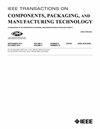A New High-Sensitivity Near-Field Composite Probe With Mirror Symmetry Design
IF 3
3区 工程技术
Q2 ENGINEERING, ELECTRICAL & ELECTRONIC
IEEE Transactions on Components, Packaging and Manufacturing Technology
Pub Date : 2025-06-23
DOI:10.1109/TCPMT.2025.3582405
引用次数: 0
Abstract
In this letter, a new high-sensitivity near-field composite probe with mirror symmetry design is presented. Unlike conventional differential magnetic-field probes that can only measure a magnetic-field component, a new differential composite probe with series loops is proposed to simultaneously test electric and magnetic field components. To increase the detection sensitivity, a pair of series loops are inserted into the conventional differential loops, which form the composite probe. Note that these series loops and differential loops are connected in series, not in parallel. The equivalent circuit models on the detection loops are used to explain the operating mechanism of the sensitivity enhancement of this design. In addition, four evolutionary models are simulated, compared, and studied to verify the effectiveness of the sensitivity enhancement. Moreover, the composite probe is together simulated, manufactured, and measured to verify the design rationality. The measured results reveal that the magnetic-field sensitivities of the probe exceed –40 dB at 0.6–5.4 GHz, while the electric-field sensitivities of that are over –40 dB at 1.3–6 GHz, respectively. Therefore, the designed composite probe not only has higher detection sensitivity but also can test the electric and magnetic field components simultaneously.一种新型镜面对称设计的高灵敏度近场复合探头
本文介绍了一种新型镜面对称设计的高灵敏度近场复合探头。与传统的差分磁场探头只能测量一个磁场分量不同,提出了一种串联回路的差分复合探头,可以同时测试电场和磁场分量。为了提高探测灵敏度,在传统的差分回路中插入一对串联回路,构成复合探头。请注意,这些串联回路和微分回路是串联的,而不是并联的。利用检测回路上的等效电路模型解释了该设计提高灵敏度的工作机理。此外,还对四种进化模型进行了仿真、比较和研究,以验证灵敏度增强的有效性。并对复合探头进行了仿真、制造和测量,验证了设计的合理性。测量结果表明,该探头在0.6 ~ 5.4 GHz范围内的磁场灵敏度超过-40 dB,在1.3 ~ 6 GHz范围内的电场灵敏度超过-40 dB。因此,所设计的复合探头不仅具有较高的检测灵敏度,而且可以同时对电场和磁场元件进行检测。
本文章由计算机程序翻译,如有差异,请以英文原文为准。
求助全文
约1分钟内获得全文
求助全文
来源期刊

IEEE Transactions on Components, Packaging and Manufacturing Technology
ENGINEERING, MANUFACTURING-ENGINEERING, ELECTRICAL & ELECTRONIC
CiteScore
4.70
自引率
13.60%
发文量
203
审稿时长
3 months
期刊介绍:
IEEE Transactions on Components, Packaging, and Manufacturing Technology publishes research and application articles on modeling, design, building blocks, technical infrastructure, and analysis underpinning electronic, photonic and MEMS packaging, in addition to new developments in passive components, electrical contacts and connectors, thermal management, and device reliability; as well as the manufacture of electronics parts and assemblies, with broad coverage of design, factory modeling, assembly methods, quality, product robustness, and design-for-environment.
 求助内容:
求助内容: 应助结果提醒方式:
应助结果提醒方式:


